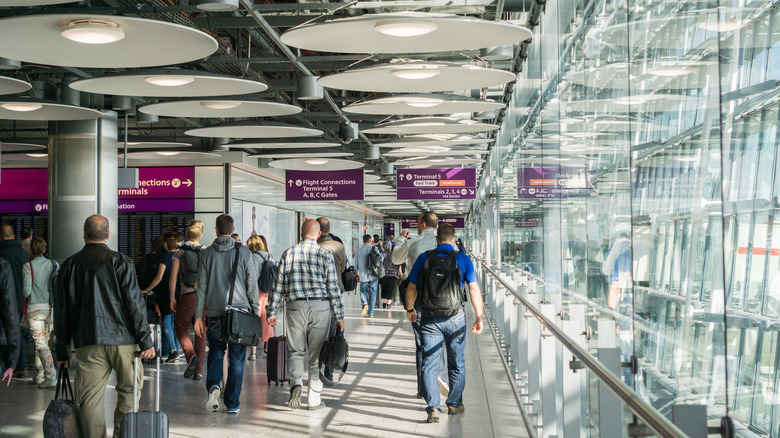Rick Steves Says The Smartest Travelers Do One Thing Before Landing At A European Airport
There is nothing worse after sitting through a long flight from the United States to Europe than trying to figure out where you're supposed to go in the airport. You're jet lagged, carrying several bags, and you have to make sure you're in the right line for passport control. While some European airports can be more stressful than others (especially Paris' Charles de Gaulle, which has been called the worst), any travel hub with crowds of people trying to figure out where they're going can cause anxiety. Enter travel expert Rick Steves, who has some advice for navigating European airports. On his website, Steves says there are a number of ways we can prepare before landing, including looking at airport maps so we know where we're heading.
"Smart travelers download airport terminal maps to their smartphones or print them out before they leave," says Steves. "You can also look for websites with detailed instructions on how to get from your arrival gate to the center of the city ... Google has even started mapping airport interiors with its Street View program." There are a number of ways to find out what the inside of the airport looks like, and navigate like you're there all the time. He's also got a few other advice gems for ways to maximize your prep before you leave the terminal.
Navigating the inside of European airports
Many airports will have terminal maps right on their official website. If you're going to one that does, download the map before you even leave your home. Then use a bit of your time on the plane to plan where you're going. If you happen to have an iOS device, you can get the app AtAirports, which has maps of hundreds of airports all over the world, with turn-by-turn directions, locations of amenities, and GPS positioning so you know where you are. (It's worth downloading your airline's app as well, as it can help if your flight is delayed or canceled.)
Google Maps for your phone or tablet has, as Rick Steves says, some airport maps as well. You simply look up the airport and click on "directory" when it comes up to pinpoint the location you want to get to. (It also has maps of other buildings like some malls and train stations where you can do the same.) There are a number of locations (with more on the way) that support Live View, which shows you where to walk with arrows on the screen.
Another site that can be helpful is ifly.com. It covers a number of airports like London's Heathrow, and gives you information like terminal maps, layover info, amenity locations, parking areas, and more, with turn-by-turn directions for some airports. It's also a good idea to make sure you have all your travel documents like your passport, any arrival cards for your group, hotel information, and plane transfer information so you're not digging in your bag as you're trying to navigate the airport.
Other things Steves suggests to help navigate through European travel
Rick Steves recommends taking advantage of your airport time. He says, "You may be jet-lagged and just want to get to your hotel, but take advantage of airport services before you leave. Stop by the tourist information office for maps, museum passes, subway tickets, and advice (usually they're less crowded than the downtown office). If you need an international phone card or SIM card for your mobile phone, you should be able to find one in an airport convenience store." What he tells us we shouldn't do is change money at one of the exchange counters. Instead, he says, "When I arrive in Europe, I head for an airport ATM, load up on cash, and keep it safe in my money belt. I've never been to an airport in Europe that didn't have plenty of ATMs."
On the way back for your trip home, it's important to know the terminal you're leaving from. Steves says, "Don't count on the taxi driver or shuttle bus driver knowing where you should be dropped off." In fact, anything you can do to help out the taxi or rideshare driver can save you time, like having where you're going written in the local language. (Use the Google Translate app or ask your hotel's concierge on the phone/internet before you leave). Knowing where you're going before you leave the airport, and looking up how much it may cost, is something Steves says can help avoid the most common taxi scams. Finally, he tells us to remember that not everything in the airport will be translated into English. Google Translate's phone feature lets you hover your camera over a sign and translates any text for you on the spot.


